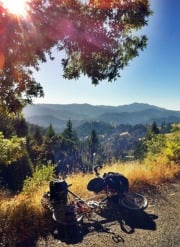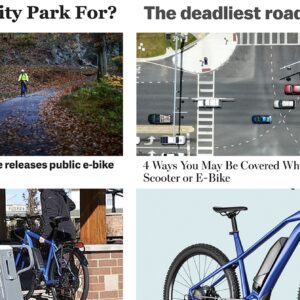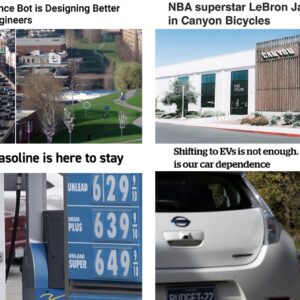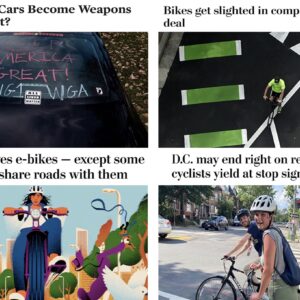
travelogue from a local bike shop owner.
(Photo: Todd Fahrner)
Here’s the news that caught our eye this week:
– Pittsburgh has announced that the city’s transit service will be cut by a whopping 35%, eliminating 47 routes and leaving 15,000 riders without a bus to catch; an estimated 9,000 more cars are expected to be driven into the city daily.
– Researchers in Melbourne found that in the course of a study using helmet cameras in city traffic, the person in the car was at fault for 87% of the collisions and near-misses they observed.
– Don’t be jealous, but in Copenhagen they’re experiencing so much traffic congestion on their famous bikeways that they’re planning to heavily invest in bicycle superhighways.
– Buoyed by the successes of Minneapolis and Denver, New York City has set its sights on being the next major US city to embrace bike-sharing.
– Reports of the infamous recent “backlash” against NYC’s latest bike lanes were overstated, according to another reporter who was also there but didn’t originally deem an event with more press attendees than protesters worth writing about.
– Meanwhile, it looks like bicycling and livable streets are officially becoming a right wing talking point, though not in a way that bodes to serve anyone well.
– One year ago, a mainstream media professional and dad in Atlanta traded in his car for a bamboo bicycle and a downtown apartment and says it’s the best thing he’s ever done. The video that goes with the story is worth watching if just to see the conditions he cheerfully rides through every day.
– A bicycle advocate in Minnesota is recovering after a serious crash which made him, he says, much more determined than before.
– The newest and most determined bicycle advocate in Maryland is the mother of Natasha Pettigrew, the young Green Party candidate for Senate who was killed while riding her bike this fall. She took over her daughter’s candidacy and is now lobbying for a vehicular manslaughter law in the state.
– It’s hard not to get inspired by this epic read about a Portlander’s epic journey down the west coast by Brompton folding bike.
– From painting crosswalks to planting gardens to replacing benches, a slideshow of “guerrilla urban improvements” to public space around the world, with plenty of links for the DIY-curious.
– And finally, the video of the week: A German electronics store has devised a clever kind of DIY bike parking…
— If you love these links, you should follow @BikePortland on Twitter.





Thanks for reading.
BikePortland has served this community with independent community journalism since 2005. We rely on subscriptions from readers like you to survive. Your financial support is vital in keeping this valuable resource alive and well.
Please subscribe today to strengthen and expand our work.
I couldn’t link to the really cool video.
You can link from here:
http://www.youtube.com/watch?v=kvc0A_cWUCU
And now I’m wondering who Gregg Woodlawn is (not that I mind the link love from Gregg!)
Regarding those right-wing talking points and the NYT article it seems transport cycling has moved on to stage three. I won’t shed any tears for the passing of the laughing/belittling stage. Just one stage left.
“First they ignore you, then they laugh at you, then they fight you, then you win.”
Mr. Gandhi
Cheers, Alistair
P.S that video is beyond awesome.
Wow, the original right-wing rant linked through that Arkansas blog is frightening. Not only for the blatant racism, but for the shocking reaction the author has to the very idea that using bikes/transit as a primary transit option. Literally fearing that reducing the number of cars is an evil communist Muslim plot.
I lived in Pittsburgh in 2001 and tried biking there once. Once was enough. If you live in PDX get on your hands and knees and thank God for our infrastructure and mostly courteous drivers! People like the Kansas woman just don’t understand it’s not about forcing people to do anything but providing options other than car based transit. That video of the man from Atlanta could have been Pittsburgh as far as safety is concerned. Making it possible to bike without fear of imminent death hardly constitutes a government takeover. I think that is the best tact for convincing people who may be on the fence or not understand us ‘bike zealots’.
Neat video from Germany. I loved it!
That device would have little effective application in the US due to the different design of our current poles used in the right of way. Most cobrahead type lamps have a pole diameter that tapers (getting thinner towards the top). And others are wooden. Though the steel pole traditionally used for tram/ streetcar power poles would work.
Re: lamp pole locking video:
You can do this with the Master Lock Street Cuff™ lock at Fred Meyer; minus the automatic lifting and lowering.
Find one of the black tapered pole decorative parking lot lights. These are about 25′ to 30′ tall and don’t put out near the amount of light the standard jumbo stadium lights lights do that are upwards of 75′ tall. These decorative parking lot lights are usually lining the sidewalk between the store building and the most adjacent parking. This gives the advantage of a very visibly locked bike in a high traffic area.
One cuff locks over the frame and back tire, as a U-lock would, and the other is closed over the light pole just enough to latch one ratchet on the cuff.
While the cuff is still loose lift bike as far as you can, leaving room to fit the key in later.
Fully close cuff. Locked now at its minimum diameter the rubber cuff sleeve on the lock cuffs now prevents any slippage even if the cuff is slightly loose.
Removal is the reverse of installation.
Only done this about 3-4 dozen times at maybe 5 different Fred Meyers: I was mostly willfully ignored, got a few chuckles and one drive by security guard that waved and shrugged. Not an official approval but I never had any problems other than the time I learned that you really need to be able to reach the lock to put the key in.
Re: Right WingerWankers-
@@%#% *&*$!@#$@!.
I need to go into psychology. There is no shortage of crazy people!
bikeradar.com’s story about the study uses one of those wildly general titles: ‘Drivers at fault in majority of cycling accidents’
Did the study facilitators even imagine their study might be able to acquire the data that would support such a general conclusion? The study facilitators title for their study:
‘Naturalistic Cycling Study: Identifying risk factors for on-road commuter cyclists’.
I don’t have any particular reason to doubt interpretation of what the study participants cameras filmed. There’s no dispute that roads can be a hectic place to travel, and that many road users are not adequately concentrating on operating their vehicle safely. The study probably captured some useful, reliable information.
“- Researchers in Melbourne found that in the course of a study using helmet cameras in city traffic, the person in the car was at fault for 87% of the collisions and near-misses they observed.” monday roundup/bikeportland
Of course. Cyclists that filmed themselves and motorists in traffic knew they had cameras on their helmet, and that their operation of their bikes would be subject to some of the same scrutiny the drivers around them would be. It logically follows they’d be especially conscious about operating their bikes in traffic, just as the story describes them having done:
“… In 88.9% of cases, the cyclist had been travelling in a safe/legal manner prior to the collision/near miss. …”.
I’m not sure, but I don’t think this study has been made available to the public yet. Stories on the web about it appear to have been based on the short ‘abstract’ (what I think of as synopsis), posted online. I wonder in what regard Monash University Accident Research Centre, or its parent Monash University is held by by the USDOT.